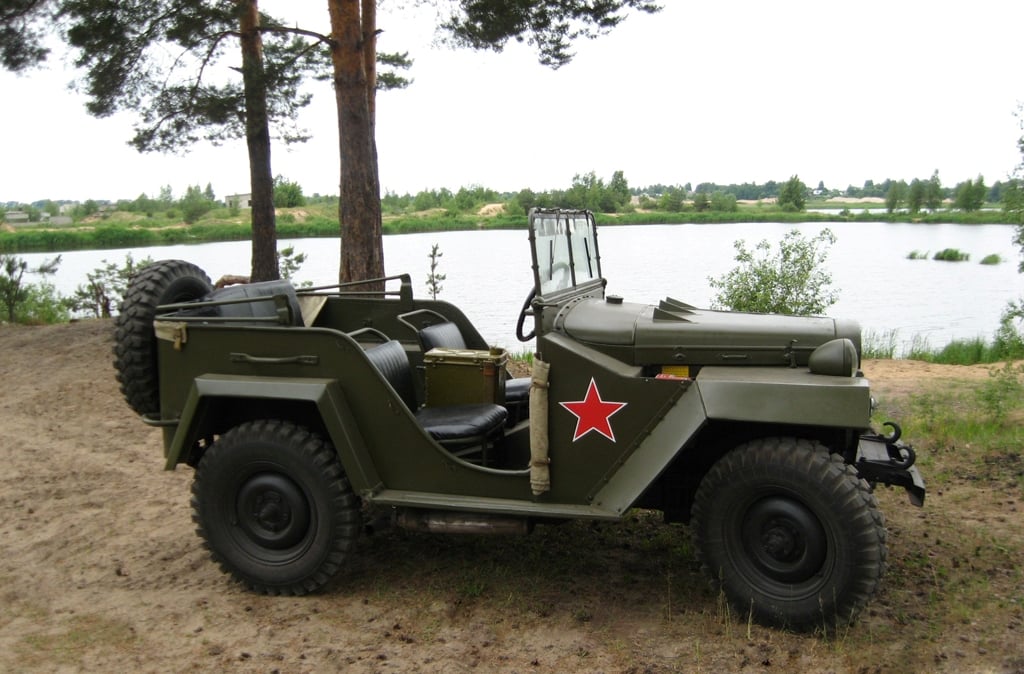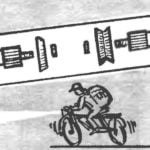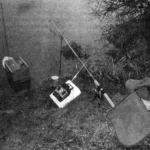
 The protagonist of our next story — GAZ-67B, one of the cars of that specific type, which during the last war became known as “jeep”. But even a few years before this model appeared design, which had Quite a big impact. Therefore, “Spent the summer of 1938, when Gorky automobile plant was built the first prototypes of the “emka” with all driving wheels.
The protagonist of our next story — GAZ-67B, one of the cars of that specific type, which during the last war became known as “jeep”. But even a few years before this model appeared design, which had Quite a big impact. Therefore, “Spent the summer of 1938, when Gorky automobile plant was built the first prototypes of the “emka” with all driving wheels.
This machine is designed under the leadership of V. Grachev, called GAZ-61-40. It was a outdoor version of “emka” (GAZ-11-40), is equipped with three-stage gearbox four-speed. From behind her, placed the transfer box were the prop shafts to the front and back leading bridges. Drive front driving axle may be disconnected.
A difficult task was designing the front axle. As its wheels were driven, they had to connect to axle shafts by universal joints, and such, which at large (35-40°) angles of rotation of the wheels would create harmful vibrations and jerks. The best solution for a machine dependent wheel suspension was ball-cardan constant velocity joint called a hinge type “Rzeppa”. Today it is widely used in the front axles of cars of the raised passableness (GAZ-69, UAZ-452 GAZ-66, ZIL-157, ZIL-131), but was then a novelty.
GAZ-61-40 had a very good maneuverability on rough terrain and dirt roads, went well and marshy, sandy, snow-covered sections of the road could take the climbs a slope to 43°. Its advantages were obvious, and in 1941, the plant began production of this machine. However, serial samples (they are assigned an index of GAZ-61) was not open body and closed, the saloon is the same as on the six-cylinder “m” GAZ-11-73 (“modelist-Konstruktor”, 1974, N° 5). By the way, the GAZ-61 was equipped with the same six-cylinder engine as the GAZ-11-73. Incidentally, cars G AZ-61 in the beginning of the great Patriotic war was used by our famous generals — K. Voroshilov, Zhukov, I. Konev.
When the war started, production “emok”, and hence the bodies on Gaza had to stop. In the first months of the front received the “pickups”, GAZ-61-415, with a canvas cabin. They were used to tow light anti-tank guns as a coherent and command. Need them on the front was huge, and in the summer of 1941, V. Grachev, given the demands of wartime, in a very short time — literally a half-two months — designed easy to manufacture the car — the GAZ-64. In fact, whole new it was only the body, front suspension and radiator. The rest of it was completed from parts and components from previous cars.
Thus, the development of the GAZ-64 did not require a significant time and cost, simplified supply of spare parts. For example, the engine, four-speed gearbox, steering gear, fuel tank and instrument panel taken from “lorry”, and the front and rear drive axles with brakes, wheels and shock absorbers from GAZ-61. However, leading the bridges had to be reconstructed — their rut was reduced from 1435 mm to 1250 mm. Why? Because a technical specification for the design of the GAZ-64 was required to create a compact command and reconnaissance car with a length of 3.33 m and a width of 1.55 m. in Order to provide the desired width of a car, had to go for alteration of bridges.


Easy-open body with folding canvas top V. Grachev designed to minimize the consumption of scarce during the war years the steel sheet. The car was missing doors (replaced with canvas sides), and the bulkhead had a small height. So if you need to speed up planting in the car you can just “jump” across the Board. The shape of the body GAZ-64 allowed all the parts to produce predominantly with a flexible and hood (requiring expensive dies) was reduced to loyal.
I must say, that of the GAZ-64 before the war was a precursor. In 1940, the Scientific autotractor Institute (now US) has developed a design of a light army reconnaissance vehicle terrain NACHI-AR. War prevented further work on this interesting machine. However, the experience of creating it was helpful in the design and construction of the GAZ-64.
Many countries, in particular Germany, England, Italy, USA, started before the beginning of the war to the production of such cars. Later named, or rather nicknamed, one of the most common models of this type — “Ford-Dzhi-PI” (it was built according to the drawings of the factory “jeep”) cars like that were called “jeeps”. And GAZ-64, production of which started in the autumn of 1941, was the first Soviet “jeep”
At the end of 1942, the GAZ-64 improved: expanded to 1466 mm rut both axles, instead of the semicircular cutouts in the bodywork over the wheels were the wings, as the track became more and body width has not changed. This step is explained by the fact that as a “jeep” and GAZ-64, which had a narrow (1250 mm) track, when driving around bends were prone to flipping. A wider track has helped to eliminate this disadvantage. The improved car received index GAZ-67, and after further modernization in 1944, he became known as the GAZ-67B. In this, the last version of machine is widespread. It was distinguished by an advantageous weight distribution on the axles, wide tires (once/lerom of 7.00—16) with cleats, quite a high ground clearance (210 mm) and small overhangs front and rear. Taken together, these features ensured the GAZ-67B was a good call, and/giosti, high traction quality. The car could tow a trailer weighing 800-1000 kg, confidently walked on the broken front road without the engine overheating (it was a radiator with six rows of cooling tubes instead of three, as in the “lorry”), a long time could move at the speed of pedestrians on a flat road speeds up to 90 km/h.

A considerable advantage of the GAZ-67B in front of the American “jeep” was the fact that the Soviet machine worked on the abundant varieties of oil and gasoline. For example, it was fuel with an octane rating of 60-64, and for “jeep” required premium gasoline with an octane rating of 70-72.
The dimensions of the GAZ-67B was small: width 1650 mm, length 3350 mm. For comparison, recall that most small-sized domestic cars of recent years, ZAZ-965, these dimensions are respectively equal to 3330 mm. 1395 and Not the last role in wartime, played a “small growth” of the machine: if you add up the awning and throw onto the hood of the windscreen, the height of the GAZ-67B was only 1.3 m, so it simplifies the masking.
On the basis of Soviet jeeps GAZ-64 and GAZ-67 during the war years produced light double armored cars BA-64 (late 1941) and BA-64B (autumn 1942). The latter had broad, as the GAZ-67, rut. A few later I saw a light floating car amphibious GAZ-011.
All these machines enjoyed a high reputation at the front and played an important role in the fighting. Therefore, the Nazis repeatedly tried to paralyze their production, exposing the Gorky plant of the bombing. Especially difficult was the summer of 1943, when from 4 June to 5 July (on the eve of the Kursk battle) the Germans had carried out 25 raids on the GAS. But neither destructions nor victims are unable to break the rhythm of factory life. Thanks to the heroism of the factory team of the consequences of the bombing were eliminated in 100 days; for comparison, in normal times, such work would take at least a year. And while it was recovering, the plant employees continued to work selflessly in the shops without roofs and Windows, working only in daylight (the plant was damaged and is not fully provided by current plant) for 18-19 hours a day. And the front had continuously received defense products, among which an important place was occupied by “jeeps” GAZ-67.
After the war, the GAZ-67B faithfully served geologists, agronomists, builders, but by 1953 was obsolete, and had to be removed from production. Was replaced by a new model GAZ-69, which was designed by the designers of the Gorky automobile plant under the leadership of N. G. Mozohina. Interestingly, its prototypes were called “Workers”, and indeed for all 19 years of production, these machines smoothly worked in the national economy and has won a high reputation among drivers. GAZ-69 has been so successful a design that it took a sample in Romania and North Korea, where factories in the cities of Câmpulung and Dikhane produced counterparts of the Soviet vehicle.

This Soviet “jeep” existed in two variants: five-seat cars (GAZ-69A) and vans (GAZ-69). The first had four and the second three-door body. In addition, on the basis of units of this car were produced amphibious GAZ-46 (also referred to as MAF).
The production of GAZ-69 Gorky began in 1952, to 1956, has transferred their production at the Ulyanovsk automobile plant. And Gorky plant meanwhile, puff remembering the pre-war GAZ-61, a comfortable sedan with all the leading^ wheels, put on the conveyor hybrid car GAZ-M72, it was made from 1955 to 195В year. Essentially, it was a “victory” with the aggregates, including both drive axles with leaf spring dependent suspension from GAZ-69. When “Victory” was replaced by “Volga” stopped production of GAZ-M72.
And UAZ? Along with the GAZ-69 and GAZ-69A it since 1958, builds trucks family
UAZ-450 with both drive axles. These trucks are the nodes in the chassis had much in common with “jeeps”, which for several years went with the Ulyanovsk Assembly line. It is interesting to note that the car UAZ-450 (by the way, they were already independent development of a team of designers UAZ), serial production of which started in October 1953, was the first domestic trucks with cab over the engine.
Mastered the production of light truck vehicles, the factory was soon established on their basis, the family needs vehicles UAZ-451 with a single (rear) drive shaft, production of which started in 1961. In 1965 Ulyanovsk upgraded their cars — instead of nizhnekayancha 62-horsepower engine, they were OHV, 70-horsepower, three-speed gearbox gave way to a four-speed. Machine with two driving axles received index UAZ-452, and with one leading axis — UAZ-451. With these cars has been standardized a new “jeep” UAZ-469, which in December 1972 took place the conveyor GAZ-69 was produced from 1953. It is produced in two versions: UAZ-469Б and UAZ-469. The latter is provided with a gear, placed the wheel hubs.
In the result ground clearance is increased from 220 mm (compared to the UAZ-469Б without gears) up to 300 mm, respectively, and increased permeability. Both options feature a versatile cargo-lifter, designed to carry seven passengers and 100 kg of cargo or two passengers and 600 kg of cargo.
When the Ulyanovsk automobile plant moved to a new model, he continued to increase the production of other machines such as vehicles (truck UAZ-452Д, van UAZ-452, UAZ minivan-452В, cars of “ambulance” UAZ-452А) and utility vehicles (truck and UAZ-451 DM and van UAZ-451 M). 1V Feb 1974 in the history of the plant was a significant event: it rolled off the millionth machine, ten-bus UAZ-452В. This in a million, a large proportion of those “jeeps”, which are derived from the Gorky GAZ-61, GAZ-64 and GAZ-67.
CAR GAZ-67B
The car GAZ 67B looks very well and does not require detailed description — all seen from the drawing and pattern. One only has to pay attention to calloused to such details as anantavijaya the body along the upper edge of the pipe, which is welded to the trim panel; vents on the hood; a folding frame metrovogo glass; decorative wheels without hubcaps and with all-terrain tires have large tread pattern; rolled and fastened by straps, canvas aprons for closing the door openings; the towing device. Because the body open, you need enough detail to show on the model of its internal structure: the steering wheel, standing under visible (indirect) angle to the longitudinal plane of symmetry of the vehicle, additional (third) gear shift lever front wheel drive, seat on a tubular frame.
As was written in the manual, “car GAZ-67B may move on any roads and terrain.” This ensured the engine-driven all-wheel vehicle, 4-speed transmission, large angles of approach and departure, high clearance between the machine body and a short wheelbase and tires with the lugs of the tread. Low tire pressure allows the car to move easily on loose and soft ground, sand, impassable for other vehicles. GAZ-67B was able to overcome fords depth to 0.7 m, steep ditches and moats.
Comparative ease of car wins to complicate the model with screening mechanisms, the Whiter they are, first, interesting, and secondly, partially visible from under the body.

Although the design of the car based on the mechanisms previously manufactured cars GAZ-61 GAZ-M1, it is supplemented by a number of units, and all together they form a completely new design. The engine of the GAZ-M1 boosted and equipped with a 6-blade fan and standard for him the gearbox attached so-called razdora box, from which departs the propeller shaft of front axle drive. The latter has solid joints for torque transfer to the wheels at different angles (while cornering), suspended from the frame by four springs chetvertinkami and well equipped with four hydraulic shock absorbers.
To give the look of a typical car GAZ-67B. during the great Patriotic war should be fixed on the body (by the belt) on the left, a digging spade, on the right — a can of gasoline, and include the standard protective green color of the machine black heels camouflage (camo).
Y. DOLMATOVSKIY, L. SHUGUROV



